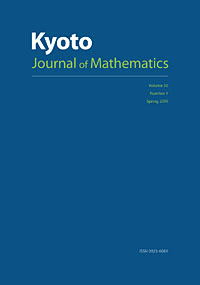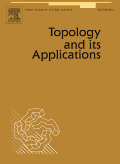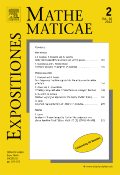
Applied General Topology
metrics 2024
Innovating the Study of Geometric Concepts
Introduction
Applied General Topology, an esteemed journal published by Universitat Politècnica de València - Editorial UPV, serves as a vital platform for researchers and practitioners in the field of topology and its applications. With an ISSN of 1989-4147 and an E-ISSN of 1989-4147, this open-access journal has been making its content freely available since 2003, thereby promoting widespread dissemination of knowledge and fostering collaboration within the mathematical community. Based in Valencia, Spain, this journal has achieved a commendable Q3 category ranking in Geometry and Topology for 2023, as well as a rank of 56/106 in the Scopus Mathematics category, placing it in the 47th percentile. Researchers and students alike benefit from its rich content and focus on both theoretical and applied aspects of general topology, making it an essential resource for advancing the understanding of geometric concepts. With coverage spanning from 2007 to 2024, Applied General Topology continues to build on its legacy, contributing significantly to the evolution of mathematical thought and practice.
Metrics 2024
 0.36
0.36 0.60
0.60 0.70
0.70 15
15Metrics History
Rank 2024
Scopus
IF (Web Of Science)
JCI (Web Of Science)
Quartile History
Similar Journals

Tamkang Journal of Mathematics
Fostering Interdisciplinary Connections through Mathematical ResearchTamkang Journal of Mathematics, published by TAMKANG UNIVERSITY, serves as a vital platform for researchers and professionals in the fields of applied mathematics, general mathematics, and materials science. With an ISSN of 0049-2930 and an E-ISSN of 2073-9826, this journal has established itself within the academic community, particularly noted for its contributions from Taiwan. Although categorized as Q4 in Applied Mathematics and Q3 in multiple related fields according to the 2023 ranking, it maintains a solid reputation for disseminating significant research findings and innovative methodologies. Researchers can explore an array of topics within its pages, making it an excellent resource for enhancing mathematical knowledge and applications. As it converges from 2005 to 2024, the journal invites academics, professionals, and students to engage with its content and contribute to the ongoing dialogue in mathematics and its interdisciplinary applications.

Facta Universitatis-Series Mathematics and Informatics
Integrating Innovation: Where Mathematics Meets InformaticsFacta Universitatis-Series Mathematics and Informatics is a prestigious interdisciplinary journal published by UNIV NIS that emphasizes the integration of mathematical theories and computational methods essential for advancements in various scientific fields. With the ISSN 0352-9665 and E-ISSN 2406-047X, this journal serves as a vital platform for researchers and professionals to disseminate cutting-edge findings related to mathematics and informatics. As an open-access journal, it aims to enhance the visibility and accessibility of high-quality research, fostering collaboration among scholars globally. The journal's commitment to excellence is evident in its rigorous peer-review process, which ensures that only the most impactful and innovative research papers are published. Set against the backdrop of its esteemed Serbian institution, Facta Universitatis not only aims to contribute to the global academic discourse but also to inspire the next generation of mathematicians and computer scientists. As the field continues to evolve, this journal plays a crucial role in shaping the future landscape of mathematics and informatics.

Revista Matematica Complutense
Fostering Innovation in the World of MathematicsRevista Matematica Complutense is a prestigious peer-reviewed journal published by SPRINGER-VERLAG ITALIA SRL, specializing in the field of mathematics. With its ISSN 1139-1138 and E-ISSN 1988-2807, the journal plays a vital role in disseminating high-quality research and fostering academic discussion within the mathematics community. Recognized for its rigorous selection process, the journal has achieved impressive rankings, holding a Q1 quartile status in the miscellaneous mathematics category as of 2023 and ranking #94 out of 399 in general mathematics according to Scopus, placing it within the 76th percentile. With a publication timeline spanning from 2008 to 2024, the Revista Matematica Complutense continues to serve as an essential resource for researchers, professionals, and students alike. Although it does not currently offer open access, the journal remains committed to advancing mathematical knowledge and providing a platform for innovative research across various mathematical disciplines.

Kyoto Journal of Mathematics
Connecting minds, sharing knowledge, transforming mathematics.Kyoto Journal of Mathematics is a premier academic publication dedicated to advancing the field of mathematics, published by DUKE UNIVERSITY PRESS. Established in 1996, this journal serves as a vital platform for sharing innovative research and breakthrough studies across various mathematical disciplines. The journal has consistently maintained a prestigious Q1 ranking in the category of Mathematics (miscellaneous) as of 2023, reflecting its significant impact and contribution to the mathematical community. With its Open Access policy, the Kyoto Journal of Mathematics ensures that groundbreaking research is easily accessible to a global audience, fostering collaboration and knowledge dissemination among researchers, professionals, and students alike. The journal's commitment to excellence and relevance in mathematical research is underscored by its extensive archive of published works and its continuous engagement with contemporary mathematical challenges. This makes the journal an essential resource for anyone seeking to stay abreast of current trends and advancements in the field.

Bulletin of Mathematical Analysis and Applications
Pioneering Theoretical and Practical Insights in MathematicsBulletin of Mathematical Analysis and Applications is a distinguished academic journal published by UNIV PRISTINA, DEPT MATHEMATICS COMPUTER SCIENCES, located in the vibrant city of Prishtina, Kosovo. This journal is dedicated to the dissemination of groundbreaking research in the fields of Mathematical Analysis and Applied Mathematics, focusing on both theoretical and practical aspects of these disciplines. While currently categorized in the Q4 quartile for analysis, applied mathematics, and miscellaneous mathematics, the journal is on an upward trajectory, welcoming contributions from researchers and professionals who strive to advance the frontiers of mathematical knowledge. Though its Open Access status is still to be developed, the journal remains committed to fostering a scholarly environment that promotes collaboration and innovation. With convergence years set from 2019 to 2024, the Bulletin of Mathematical Analysis and Applications aims to be an essential resource for those pursuing advancements in mathematics, providing a platform for new ideas and methodologies to flourish.

TOPOLOGY AND ITS APPLICATIONS
Pioneering Insights in Topology and Its ApplicationsTopology and Its Applications is an esteemed journal within the field of mathematics, specifically focusing on topology and its various applications. Published by Elsevier, it serves as a significant platform for researchers, professionals, and students interested in the intersection of geometry and topology. The journal has been operational since 1980 and continues to contribute to advancements in the field with its broad scope that encompasses theoretical developments and practical applications. With an impact factor that reflects its importance in the academic community, it currently holds a Q3 ranking in Geometry and Topology as per the 2023 category quartiles. The journal is indexed in Scopus, ranking #59 out of 106 in its category, which places it within the 44th percentile among other publications. Although it does not offer open access, it remains a vital resource for those engaged in cutting-edge topology research. Researchers looking to engage with innovative studies and contribute to ongoing discussions in this dynamic field will find this journal indispensable.

Journal of Fixed Point Theory and Applications
Unveiling the Dynamics of Fixed Point Interactions.Journal of Fixed Point Theory and Applications is a prestigious academic journal published by SPRINGER BASEL AG, dedicated to advancing research in the fields of applied mathematics, geometry and topology, and modeling and simulation. With an impressive convergence of research spanning from 2007 to 2024, this journal has established itself as a pivotal platform for disseminating innovative findings and theoretical developments. The journal holds a Q2 quartile in multiple mathematics categories, demonstrating its significant impact and standing within the academic community, particularly evident in its Scopus rankings where it is positioned in the 89th percentile for Geometry and Topology. Although it operates without an open access model, the journal's rigorous peer-review process ensures the highest standards of quality, making it an invaluable resource for researchers, professionals, and students seeking to explore the dynamic interactions between fixed point theory and its diverse applications. Set in Basel, Switzerland, the journal embodies an international scope, inviting contributions that push the boundaries of mathematical research.

EXPOSITIONES MATHEMATICAE
Championing Excellence in Mathematical ScholarshipEXPOSITIONES MATHEMATICAE, published by Elsevier GmbH, stands as a significant journal in the realm of mathematics, catering primarily to researchers, professionals, and students. With an ISSN of 0723-0869 and an E-ISSN of 1878-0792, this journal has made its mark in the academic community, boasting a Q2 classification in the miscellaneous mathematics category for 2023, illustrating its prominence within its field. The journal addresses a diverse scope of mathematical topics, encouraging the publication of original research and innovative theories while maintaining rigorous academic standards. As it converges from 2004 to 2024, EXPOSITIONES MATHEMATICAE continues to be an essential resource for advancing mathematical knowledge and fostering scholarly communication, despite being a non-open-access publication. Its location in Munich, Germany further anchors it within a rich intellectual tradition, providing accessibility for the mathematical community worldwide.

Pure and Applied Mathematics Quarterly
Cultivating Dialogue in the Evolving World of MathematicsPure and Applied Mathematics Quarterly is a prestigious journal published by INT PRESS BOSTON, INC, focusing on the diverse and evolving field of mathematics. Since its inception in 2007, this journal has grown significantly, currently holding a Q1 ranking in the Mathematics (Miscellaneous) category for 2023, positioning it among the leading publications in the discipline. With a commitment to publishing high-quality research, Pure and Applied Mathematics Quarterly fosters innovation and dialogue within the mathematical community by providing a platform for theoretical advancements and practical applications. The journal remains accessible to researchers and professionals through its ISSN 1558-8599 and E-ISSN 1558-8602, although it does not currently offer open access. As a vital resource for mathematicians, educators, and students, this journal endeavors to expand the frontiers of mathematical knowledge and contribute to the academic dialogue surrounding this fundamental science.

COMMUNICATIONS IN ANALYSIS AND GEOMETRY
Connecting Theory and Application in MathematicsCOMMUNICATIONS IN ANALYSIS AND GEOMETRY, published by INT PRESS BOSTON, INC, is a prestigious journal dedicated to advancing the fields of analysis, geometry, and statistics. With an impressive Q1 ranking in these categories for 2023, the journal stands out as a leading platform for cutting-edge research and scholarly discourse. Established in 1996, the journal has been instrumental in fostering a vibrant academic community that engages with both theoretical and applied aspects of mathematics. Despite not being an open-access journal, it continues to attract a wide readership owing to its rigorous peer-review process and high-impact publications. The journal's influence is further underlined by its respectable Scopus rankings, specifically in Geometry and Topology, where it ranks 40th out of 106, highlighting its significance in the scholarly landscape. Researchers, professionals, and students alike will find COMMUNICATIONS IN ANALYSIS AND GEOMETRY to be an invaluable resource for the latest findings and developments in these interconnected mathematical disciplines.